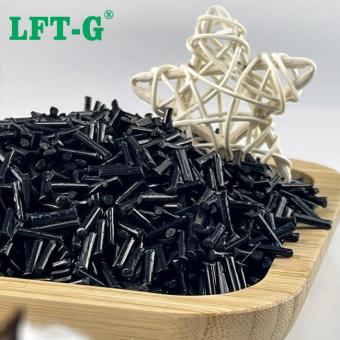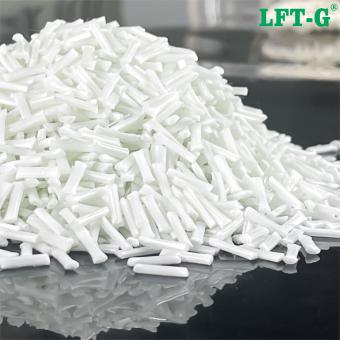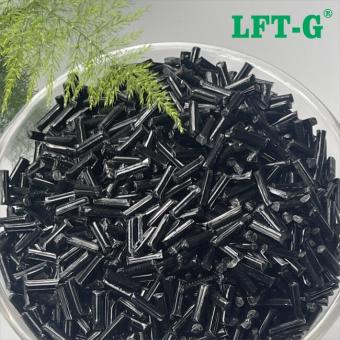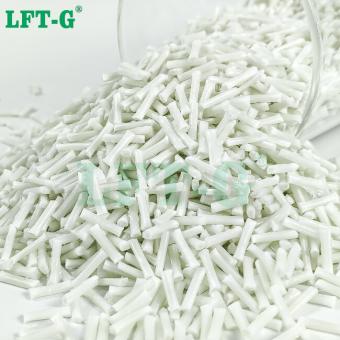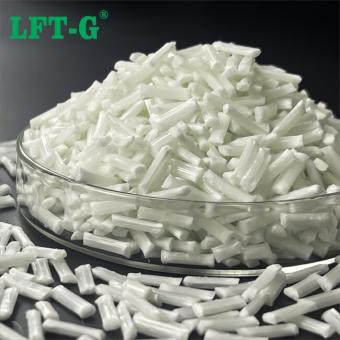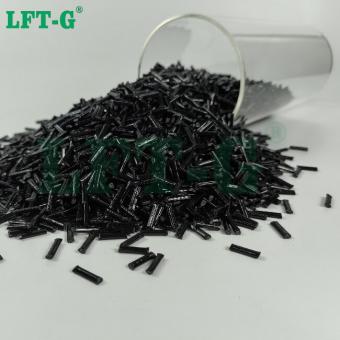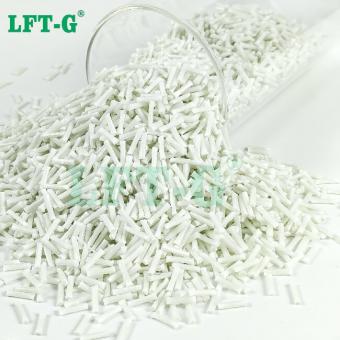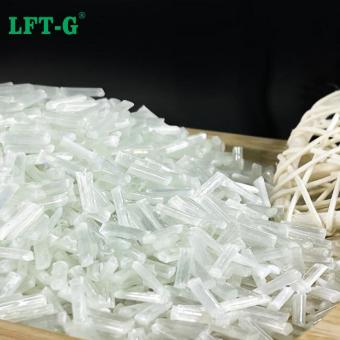-
Compuestos reforzados con fibra de carbono larga LFT Nylon Poliamida 66PA66-CF40 es un PA 66 reforzado con un 40% de fibra de carbono larga, que ofrece resistencia, resistencia a la fluencia, rigidez y estabilidad dimensional excepcionales. Después de la modificación, PA66-CF40 exhibe excelentes propiedades mecánicas, lo que lo hace altamente resistente e ideal para aplicaciones de carga alta en ambientes de temperaturas extremas. Este material es particularmente adecuado para componentes que requieren alta resistencia y durabilidad durante períodos prolongados, como cubiertas y piezas estructurales en máquinas y vehículos.
- PA66 Relleno de PA CFRP 40 30 20
- aplicación de polímero pa66-cf30
- Resina termoplástica fabricada en China.
- Gránulos de resina de polímero de filamento pA66
- EDM al por mayor en stock de materiales PA 66
- Mejor precio PA66 de alta resistencia
Etiquetas :
-
Compuestos reforzados con fibra de vidrio larga de poliamida 66 de nailonLas propiedades mecánicas del nailon 66 reforzado con fibra de vidrio larga (LGFR-PA66) son obviamente mejores que las del nailon 66 reforzado con fibra de vidrio corta (SGFR-PA66), y el rendimiento del procesamiento de moldeo también es mejor. Puede moldearse mediante diversos métodos de moldeo, como moldeo por inyección y moldeo por compresión, y también se pueden formar componentes complejos.
- PA66 Relleno PA GFRP 40 30
- aplicación de polímero pa66-gf30
- filamento de fibra de vidrio pA66
- Venta al por mayor de electroerosión en materiales PA 66 en stock
Etiquetas :
-
Nylon Poliamida 6 Relleno Compuestos largos reforzados con fibra de carbonoLos compuestos de fibra de carbono larga PA6 ofrecen resistencia, rigidez y bajo peso excepcionales, lo que los hace ideales para aplicaciones de alto rendimiento en industrias como la automotriz, aeroespacial y electrónica. Estos materiales proporcionan propiedades mecánicas superiores, incluida una alta resistencia a la tracción y una excelente resistencia a la fatiga, al tiempo que garantizan una mayor estabilidad dimensional en condiciones extremas. Los compuestos de fibra de carbono larga PA6 son una solución confiable para reemplazar metales en componentes estructurales livianos y exigentes.
- PA6 Relleno de PA CFRP 40 30
- aplicación de polímero pa6-cf30
- filamento de fibra de carbono pA6
- Venta al por mayor de electroerosión en materiales PA6 en stock
- Mejor precio PA6 de alta resistencia
Etiquetas :
-
Poliamida 6 de nailon con relleno, compuestos largos reforzados con fibra de vidrioEl nailon reforzado con vidrio, o PA6-GF, emplea PA6 (poliamida 6) como compuestos básicos. Policaprolactama (PA6) es otro nombre para Nylon 6 o PA6. PA6-GF funciona bien a bajas temperaturas y tiene gran tenacidad y resistencia al impacto. También tiene alta estabilidad dimensional y absorción de humedad. El contenido de fibra de vidrio en PA6 GF oscila entre el 20% y el 60%. La resistencia y la rigidez aumentan al aumentar el contenido de fibra de vidrio, mientras que la tenacidad y la resistencia al impacto disminuyen.
- PA6 Relleno de PA PRFV 40 30
- aplicación de polímero pa6-gf30
- filamento de fibra de vidrio pA6
Etiquetas :
-
Polipropileno homopolímero que llena el polímero largo de la fibra de carbono para el automóvilLos compuestos de fibra de carbono larga de PP homopolímero ofrecen excelentes propiedades mecánicas, que incluyen alta resistencia, rigidez y resistencia al impacto. Estos materiales son ideales para aplicaciones de alto rendimiento en sectores automovilístico, aeroespacial e industrial, donde las soluciones ligeras pero duraderas son esenciales. Con una estabilidad dimensional y una resistencia térmica superiores, los compuestos de fibra de carbono larga de homopolímero PP proporcionan una alternativa confiable a los metales en entornos exigentes.
- Fibra de carbono de alta dureza pp.
- Fabricación de resina de polipropileno en China.
- Filamento de fibra de carbono pp CF CFRP
- Venta al por mayor de electroerosión en materiales PP en stock
- Mejor precio PP de alta resistencia
Etiquetas :
-
Fibra de carbono larga de polipropileno de copolímero de resistencia extra alta rellenaEl polipropileno (PP) reforzado con fibra de carbono larga de copolímero combina los beneficios de las fibras de carbono largas y la flexibilidad de los copolímeros de PP, ofreciendo resistencia, rigidez y resistencia al impacto excepcionales. Es ideal para aplicaciones exigentes en industrias como la automotriz, la electrónica y la aeroespacial, donde un alto rendimiento mecánico y un peso reducido son esenciales. Este material proporciona una estabilidad dimensional superior, resistencia al calor y una resistencia mejorada a la fatiga y al desgaste.
- fibra de carbono
- CFRP reciclado Ligero en lugar de metal
- pp reforzado con fibra de carbono
- piezas impresas en 3D de fibra de carbono
- Mejor precio PP de alta resistencia
Etiquetas :
-
Polipropileno homopolímero con relleno largo reforzado con fibra de vidrio para inyecciónEl polipropileno (PP) reforzado con fibra de vidrio larga homopolímero ofrece excelentes propiedades mecánicas, que incluyen alta resistencia, resistencia al impacto y estabilidad dimensional. Con un contenido de fibra de vidrio que oscila entre el 20% y el 60%, es ideal para aplicaciones en automoción, maquinaria industrial y herramientas eléctricas, proporcionando una alternativa ligera pero duradera a los metales tradicionales.
- uso de electrodomésticos homo PP
- Fábrica de fabricación de resina de polipropileno.
- Uso de moldeo por inyección itinerante de fibra de vidrio pp
- Materiales PP personalizados
- Mejor precio PP alta dureza ligero
Etiquetas :
-
Polipropileno Copolímero Con Relleno Largo Reforzado Con Fibra De Vidrio Para InyecciónLos compuestos reforzados con fibra de vidrio larga de PP ofrecen excelentes propiedades mecánicas, que incluyen alta resistencia a la tracción, resistencia al impacto y estabilidad dimensional, lo que los hace ideales para aplicaciones exigentes. Estos materiales se utilizan ampliamente en los sectores automoción, electrodomésticos y industrial, donde la durabilidad y el rendimiento son fundamentales. Con un contenido de fibra de vidrio que oscila entre el 20 % y el 60 %, proporcionan un equilibrio entre resistencia y reducción de peso, lo que mejora la eficiencia general del producto final.ver más
-
Xiamen LFT-G Alta dureza MXD6 compuesto relleno fibra de vidrio larga color originalNylon - MXD6 es un tipo de resina de poliamida cristalina, que se sintetiza mediante la condensación de m-benzoilamina y ácido adípico.
- Resina de nailon cristalino mxd6 gf buen precio
- Materiales compuestos con fibra de vidrio larga mxd6
- Plástico de mayor rendimiento mxd6
- Productos fabricados en China compuestos mxd6
- Fibra de vidrio plástica personalizada agrega mxd6 de alta resistencia
- resina termoplástica resina termoplástica
Etiquetas :
-
Pellets de compuestos rellenos de fibra de vidrio larga de plástico de poliamida LFT Nylon 12PA 12 (también conocido como Nylon 12) es un buen plástico de uso general con amplias aplicaciones de aditivos y es conocido por su dureza, resistencia a la tracción, resistencia al impacto y capacidad de flexionarse sin fracturarse. Los moldeadores por inyección han utilizado PA 12 durante mucho tiempo debido a estas propiedades mecánicas.
- Moldeo por inyección de alta resistencia al impacto
- resina termoplástica modificada LFRT
- piezas estructurales engranajes y cojinetes de automóviles
- plástico de ingeniería versátil
- fabricante de polímeros de precio de fábrica de China
- resina plástica PA 12 a buen precio
Etiquetas :
-
Compuestos termoplásticos reforzados con fibra de vidrio larga de poliuretano termoplástico (TPU) Xiamen LFTEl poliuretano termoplástico es suave y elástico, con excelente resistencia a la tracción y al desgarro. Por este motivo, suele utilizarse para fabricar piezas que exigen una elasticidad similar a la del caucho. El TPU es un poco más caro que otras resinas, pero no hay sustituto para muchas aplicaciones, como las cubiertas protectoras de cables y alambres. Otra ventaja es que el TPU mejora el agarre de los productos que deben sujetarse de forma segura en la mano. Acerca de los compuestos TPU-LGF ¿Qué productos se fabrican mejor con poliuretano termoplástico (TPU)? Algunos de los productos de TPU fabricados son paneles de instrumentos de automóviles, ruedas giratorias, artículos deportivos, herramientas eléctricas, correas de transmisión, dispositivos médicos, calzado, etc. ¿Qué es el poliuretano termoplástico (TPU) para moldeo por inyección de plástico? ETPU es una resina dura y altamente resistente a la abrasión que cierra la brecha entre cauchos y plásticos. Los TPU se pueden formular para que sean rígidos o elastoméricos. El TPU presenta una gran flexión antes de romperse y es ideal para ruedas y paneles de puertas. ¿Cuál es la temperatura de moldeo del poliuretano termoplástico (TPU)? dependiendo del TPU que se esté moldeando. Detalles de materiales Númeronúmero TPU-NA-LGF Colorr Color natural o personalizado Longitudlongitud 6-25 metrosmetros Paquetekg 25 kg/bolsa MOP 25kg Ladelante tiempo 2-15 días Puerto de Cargag Puerto de Xiamen Comercioteempresas EXW/FOB/CFR/CIF/DDU/DDP Acerca de Xiames LFT Xiamen LFT Composite Plastic Co., LTD se estableció en 2009 y es una marca global de proveedores de materiales termoplásticos reforzados con fibra larga que integra investigación y desarrollo de productos (I+D), producción y marketing de ventas. Nuestros productos LFT han pasado la certificación del sistema ISO9001 y 16949 y han obtenido muchas marcas comerciales y patentes nacionales, que cubren los campos de automoción, piezas militares y armas de fuego, aeroespacial, nuevas energías, equipos médicos, energía eólica, equipos deportivos, etc. Materiales de ingeniería termoplásticos reforzados con fibra larga LFT, en comparación con los materiales termoplásticos reforzados con fibra corta ordinarios (la longitud de la fibra es inferior a 1-2 mm), el proceso LFT produce fibras de material de ingeniería termoplástico en longitudes de 5-25 mm. Las fibras largas se impregnan con la resina a través de un sistema de molde especial para obtener tiras largas que quedan completamente impregnadas con la resina y luego se cortan a la longitud necesaria. La resina base más utilizada es el PP, seguida de PA6, PA66, PPA,PA12,MXD6,PBT,TPU,PPS, ABS,PEEK, etc. Las fibras convencionales incluyen fibra de vidrio y fibra de carbono. Dependiendo del uso final, los productos terminados pueden usarse para moldeo por inyección, extrusión, moldeo, etc., o usarse directamente para plástico en lugar de acero y productos termoestables.
- Plásticos de ingeniería termoplásticos de alto rendimiento.
- excelente resistencia al calor con relleno
- productos de moldeo por inyección de peso ligero
- excelente resistencia a la tracción y al desgarro
- El fabricante de plástico modificado se puede personalizar.
- se puede reciclar GFRP GF30
Etiquetas :

 correo electrónico
correo electrónico español
español English
English français
français Deutsch
Deutsch русский
русский italiano
italiano português
português العربية
العربية 日本語
日本語 한국의
한국의 中文
中文














